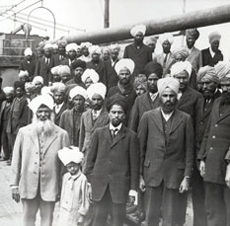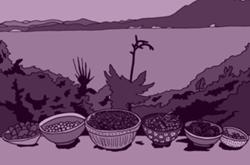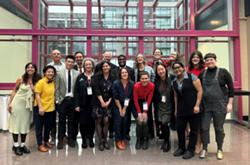
How much has Vancouver really changed since 1914? The Vancouver Sun was writing reactionary editorials back then, and it's doing the same thing now. Canada's Immigration policies have also had their ups and downs since the Komagata Maru sailed into Burrard Inlet on May 23, 1914. The Continuous Journey Regulation of 1908 which stated that ships could not enter Canada if they had to refuel from their original point of departure, bears an uncanny resemblance to the recent Safe Third Country legislation (which disallows entrance from the US for refugees claimants).
That was then and -- in some ways that are important for all of us to understand -- this is still then.
Director Ali Kazimi makes this point explicit in his new film Continuous Journey. Kazimi's documentary is an exhaustive exploration of the story of the ill fated Komagata Maru, its 376 passengers, and the chain of events set off by its forcible expulsion from Vancouver's harbour 91 years ago. This one incident had world-changing implications.
At that time, the world was still largely covered by the British Empire. Vancouver was a sleepy little part of the Dominion, with its own racist underbelly; from the beer hall hit, White Canada Forever, to the Chinese head tax, it was not the cultural mosaic we've come to know and feel smug about. As the film makes explicit, there was a very clear policy from the highest levels of government that Canada was a white man's country. Immigrants were allowed, if, like the Chinese they paid a head tax, or like the South Asian community, they worked as labourers, and were allowed no fundamental rights or privileges. The South Asian community didn't gain the right to vote until almost 1950.
Power for the pale
When the Komagata Maru sailed into the Port of Vancouver, its arrival had been preceded by a furious editorializing in the local papers predicting a mass invasion. Feeling was already running high, and when the ship was refused landing, the stage was set for an epic standoff that soon involved, not only the Canadian government and the South Asian community of Vancouver, but also quickly spread to Mother India and England. Kazimi spent eight years researching the film, and this dedication is amply evident in the unprecedented information he has uncovered, such as memos from William Lyon MacKenzie King, interviews with the surviving relatives from the ship, and even footage of the ship itself, which Kazimi literally stumbled upon.
Kazimi lays out all the players from the minor to the major; Prime Minister Robert Borden and MacKenzie King all had a role in the drama that unfolded, but the central figure in the story was an Indian businessman named Gurdit Singh. Singh chartered the Komagata Maru in Hong Kong, sold tickets to his countrymen, and loaded the ship up with a cargo of coal (which came in handy to throw at Vancouver police when they tried to forcibly board the vessel). Gurdit Singh's theory was that the passengers of the boat, being part of the British India, should be able to move anywhere they liked within the Empire. Unfortunately for him and the rest of the passengers, this policy only applied to the palest members of the British Empire.
Cold officialdom
Making a documentary in which there is very little filmed footage of events requires some creativity. Using still images, animation, newspaper clippings, and archival footage, Kazimi recreates the Vancouver of 1914. Because there are so few images of the main participants, the same photographs are used repeatedly. Gurdit Sigh is often shown blinking in the glare of history like a startled owl. Some of the voiceovers, like immigration official Reid, and H.H. Stevens, stack the deck a little too obviously; they sound like villains from the Snidely Whiplash School of the Dramatic Arts. The coldness and formality of the official letters, telegrams and government documents is chilling enough, it doesn't need a heavy hand to make the tragedy more apparent, the facts speak for themselves.
The sheer density of information is also overwhelming. History rarely wraps up nicely, and seeking to condense such a complex and sprawling saga into 88 minutes is a feat. In the Q&A that accompanied the gala screening, Kazimi said that his first version of the story was 400 pages long, but the film could still use some more edits to further focus the film without sacrificing the complexity of the incident and its related effects.
One of the most powerful chapters occurs late in the film, when the ship finally returns to India. A scuffle between British forces and the passengers turns into the bloodbath of Budge Budge Harbour. This is the pivotal point of the tragedy, and it could use a closer examination, since it helped to touch off the Indian struggle for independence. Whether the fate of the Komagata Maru and its passengers ultimately sealed the fate of the British Empire is hard to say, but the ship's impact on the history of Indian independence cannot be disputed. Gurdit Singh went on to embrace the style of nonviolent revolution led by Ghandi, and everything else is history.
But history is still very much with us. It's a tangled web and following one skein often leads to another, even bigger, tangle. Five days after the ship left Vancouver, the world was at war.
Up to date
There is a temptation when watching a story that happened almost one hundred years ago to think, well, that's terrible, but things have changed. But have they? The story of Maher Arar, the report on racial profiling, even the torturous saga of the Air India bombing aren't just recent events, they're immediate, on the news just yesterday. So too, stories similar to the Komagata Maru are happening right now.
Rick Goldman writing in the Montreal Gazette about Canada's Third Country Agreement said, "Under this agreement, Canada has effectively closed its land border to refugees... According to the United Nations High Commission for Refugees, there are about 10 million refugees in the world. Most of them never make it far from the troubled countries they are fleeing. For example, Pakistan is currently "host" to the largest number of refugees in the world, followed by Iran. Each has about one million, that is, 10 percent of the world's refugees. Canada, for its part, is host to about 1.3 per cent of the world's refugees."
The roots of xenophobia go right down to our lizard brain, but anyone who has driven through large stretches of rural Canada where there is absolutely nobody about, can't help but wonder, "What's all the fuss about? Isn't there more than enough room for everybody in this enormous country?" Certainly we have a lot more room than does Spain, where an amnesty has been declared for the country's approximate 700,000 refugees.
The No One is Illegal March in support of refugees rights begins June 18 in Montreal and ends in Ottawa on June 25.
If the film offers one overall lesson, it's that history is what we make it.
Dorothy Woodend reviews films on Fridays for The Tyee. ![]()















Tyee Commenting Guidelines
Comments that violate guidelines risk being deleted, and violations may result in a temporary or permanent user ban. Maintain the spirit of good conversation to stay in the discussion.
*Please note The Tyee is not a forum for spreading misinformation about COVID-19, denying its existence or minimizing its risk to public health.
Do:
Do not: